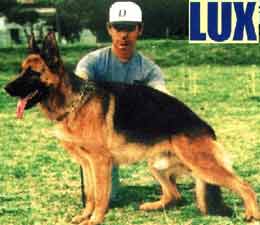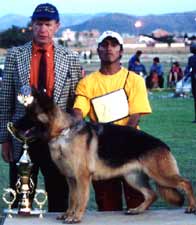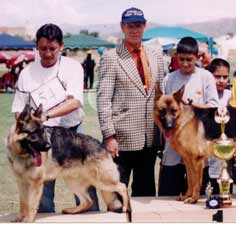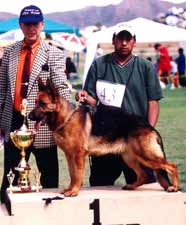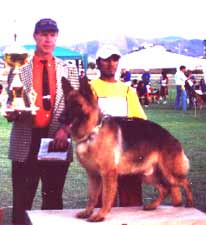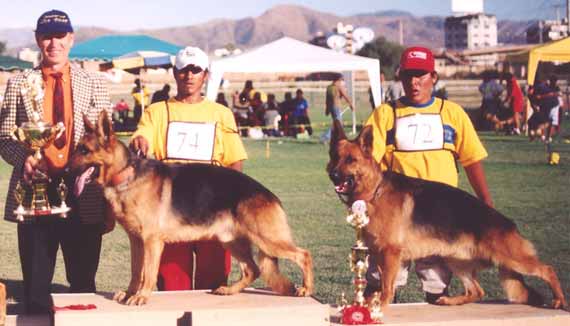At the beginning of December, after attending the
big camelid (alpacas, mostly) festival in Arequipa and the 2003 Peru Sieger
Show in Lima, I traveled to a new country for me, Bolivia. This is a 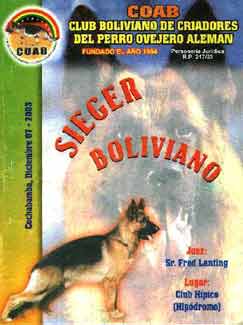 country
approximately the size of Texas, but would be bigger than Alaska and Texas
combined if it were flattened out. It is less densely populated than Peru, with
a national population of 7 million, equal to just the city of Lima alone. It’s
in the rugged Andes mountain chain, and the elevations are certainly imposing.
It took a day to get to La Paz, the biggest city (1.3 million), by plane, bus,
and taxis, and another day to travel overland to Cochabamba in the deep
south-center of the country. It took two and a half days to get from the show
site venue back home to Alabama, including one short night in a hotel and
layovers. Talk about remote!!!
country
approximately the size of Texas, but would be bigger than Alaska and Texas
combined if it were flattened out. It is less densely populated than Peru, with
a national population of 7 million, equal to just the city of Lima alone. It’s
in the rugged Andes mountain chain, and the elevations are certainly imposing.
It took a day to get to La Paz, the biggest city (1.3 million), by plane, bus,
and taxis, and another day to travel overland to Cochabamba in the deep
south-center of the country. It took two and a half days to get from the show
site venue back home to Alabama, including one short night in a hotel and
layovers. Talk about remote!!!
The Bolivian committee that organized the shows was so kind as to send an air ticket to Lima Peru, so I could attend the Peruvian Sieger Show and work on getting my next book printed there, before going on to Bolivia to judge their Sieger Show. This gave me the opportunity to see more of the Inca lands than I could have by taking just the flight to Bolivia. Experiencing the inner life of these marvelous countries, with the hardships of travel and the privations of the people, gives real meaning to the Latino phrase, “meat comes with bone”. Next time I pick my way through the bones in a Rhine River fish or Mexican cabrito, I will think of that saying and my trip through Bolivia.
Bolivia is one of several countries where dog club matters are as turbulent as their national politics (They had riots and a call for the resignation of their president shortly before I left home). We find fanciers divided into camps (as everywhere) according to personality strengths, disagreements over petty things, and preferences between work and show line GSDs; some of the first reasons are what tear the all-breed clubs apart as well as the specialty clubs. The GSD is by far the largest population of purebred dogs, and so its fanciers can effectively control the fate of dog clubs in Bolivia.
We have already seen the GSD breed split into two or three groups, parts, or even separate clubs in the U.S., Uruguay, Chile, Peru, the U.K., Australasia, as well as Slovenia and other parts of Europe. In Bolivia, for years the FCI-member all-breed club has been owned (literally!) by one man, named Señor Quiroga. Dissidents broke the connection a few years ago and formed the ACB for the all-breed functions and the COAB for the GSD people, and immediately took 80% or more of the membership with them.
When I accepted the invitation to judge the Bolivia Sieger Show (national annual GSD specialty) and an all-breed show the first weekend in December, I knew nothing of the revolutions going on in the dog and political worlds there. When I found out about the riots, we had already bought the air tickets, but I probably would not have canceled, anyway — even though the U.S. government had recalled people and issued a warning not to travel there. When the posters and Internet announcements of the show came out, I got a letter from the FCI- affiliated kennel club ruled by Quiroga, saying that I should not accept the assignment, and that if I turned it down, he would invite me to judge the next year at his show. It’s a good thing I did not take the bait, as his shows are pulling only about 50-60 dogs total, all breeds! Besides, once I make a commitment, I stick to it. That’s the way my mother taught me.
Bolivia has no seaport. The previously immense country used to, but due to half a dozen ancient wars in previous centuries with neighboring countries (all of which they lost, partly to much smaller population), it is now a land-locked, mountainous nation smaller than it had been when it was first formed; it is reached only by air and long, winding roads. Elevation in some principal cities is much higher than the U.S. mile-high cities of Denver and Albuquerque. La Paz is 3,700 meters (over 12,000 feet), nearby El Alto (700,000 people) is 13,000 ft., and there is a much higher mountain pass (about 16,000 ft.) between them and Cochabamba (“only” 9,000 ft.) where the shows were held. Most of the terrain between the airport where we first landed (Juliaca, Peru, a couple hours from the northwestern end of Lake Titicaca) was about 12-13,000 feet.
Where the air is rare, you need to breathe faster and deeper than normally in an attempt to get oxygen into your bloodstream and to your cells. It’s almost a futile effort, though, and the inefficiency of your body to make enough red blood cells and/or improve hemoglobin uptake of oxygen makes you feel out of breath all the time. Any exertion at all makes you feel like you have just run half a marathon. Even talking a lot, like my Limeño friend did when he arrived. Or simply getting out of bed and dressing. You notice the difference just walking across the room, so you can imagine what I felt like when I walked short distances, and I had to stop twice per block to sit down before resuming the steep climb up the roads (hardly any in La Paz are less steep than a ski-slope).
I have seen people get altitude sickness in Cuzco (12,000 ft.) and even in Arequipa and Machu Pichu (9,000 ft.), but I can’t be sure that I would have gotten their debilitating headaches, cramps, and nausea if I had not been drinking the coca tea. Yes, the brew is made from the leaves of the same plant that cocaine is extracted from, but the stimulation feature in the tea is barely noticeable. The other 13 or so alkaloids are probably given as much credit or more in fighting fatigue and preventing the sickness. Still, the coca-leaf tea does nothing to prevent the light-headed feeling of oxygen deprivation. It takes 15-30 days to become adapted to such elevations, and if you spend less time there, it can take weeks to get rid of the out-of-breath feeling after exertion even though you may be back at sea level.
The trip from Lima was by air to Juliaca, and a dog that had been trained in Lima was on the same plane. There I met up with the president of both the GSD and all-breed clubs in La Paz, Dr. Cristian Molina, and we headed for the capital and his home. His dog (in the crate) was strapped to the top of the rickety old bus along with bicycles, luggage, backpacks, etc. and we began the 8-hour incredible ride to the border town of Desaguadero. On the way, we saw the reed boats on the world’s highest lake, made the same way they had been for thousands of years. Donkeys piled with reeds for thatching the roofs of the tiny mud and stone houses made their way through herds of alpacas and sheep, and fishermen in wooden boats further from shore tended the pens where they raised trout and other lake fish. They move these pens every few days to refresh the food supply and get away from the droppings.
The bus was packed with all sorts of people too poor or frugal to fly, including very round Andean women made even rounder by (I assume) at least a dozen layers of wrappings, with tiny derbies perched jauntily atop their heads, and colorful blanket back-bundles carrying their belongings and babies. Some of the passengers have enough money from mining and farming various crops but there is no air service between many cities like Juliaca, Puno, or Desaguadero, and bigger cities like La Paz. Legroom in these Japanese vehicles was certainly not designed with tall Gringos in mind. We wended southeast through Puno and much smaller settlements as dusk fell.
Before and after clearing Immigrations in the late darkness, we hand-carried into Bolivia the dog crate and our luggage (I had 4 pieces), my guide amused at my puffing and panting, and found a Combi, the ubiquitous van-taxi that would take us the next several hours to La Paz. Again, the dog rode on top, and we squeezed about 12 or 13 people into the 6-or 7-passenger van. My luggage was crammed under and on top of my knees, and I looked (and felt) like a Chullpa, the pre-Columbian mummies buried in a severely compact squatting position, knees at the chin, taking up considerably less room than a kitchen chair. I found it hard to straighten up after we reached La Paz.
The first view of La Paz gives two impressions. The approach from the northwest is so crowded and certainly not the most uncluttered place, that the level of chaos and stuff on the streets is even worse than certain boroughs of New York City! Some cities in the Andean countries and Paraguay are sometimes called “little Calcuttas”, and La Paz was like a nearly-vertical Calcutta The other impression is that of descending into the Kennecott copper mine (the largest in the world, I think) except that instead of a continuous spiral, the road snakes down switchbacks and very narrow cobblestone roads like a serpent in a hurry to get to Hell. The ascending southern side on the other side of the main business areas is cleaner and more affluent, though still incredibly crowded. It is a fascinating, bustling city with many museums and other evidences of ancient cultures. I saw many tourists from afar there. The people (outside the more dangerous sections) are very friendly and happy to talk to foreigners. Food is “picante”, and the rich seafood or mixed meat stews called “Menudito” are delicious.
After I was in La Paz three days, my friend Javier from Lima caught up with us. We had left him in Juliaca where he visited area Alpaca ranches and make valuable business contacts and deals. We puffed and panted another day in La Paz, then took another all-day generally-downhill bus trip to arrive in Cochabamba at 3:30 in the morning. Even at 2700 meters, it is considered on the downhill side of the Andes, leading toward the Amazon River’s tributary basins, though the jungle is still a couple days away. This attractive city was the location for the two shows I was to officiate for. Even in the middle of the night, we were met by a wide-awake welcoming committee, as Latin-Americans typically are “buos” or night-owls.
Saturday morning, as is my custom, I automatically awoke before 6 a.m., had my breakfast and coca tea, and waited for GSD club members to pick us up. First on the agenda for me was to give a grooming, handling, and training seminar and then to conduct a Körung (breed survey) for several GSDs. (I also was scheduled to present a grooming and handling seminar for the all-breed people before leaving the city.) As is typical in Hispano-America, the courage test that formed part of the intensive evaluation and followed the measurements, consists of the helper in the second portion running away from the dog, turning at the end of the field, and meeting the dog who has already been released to chase him. We in Europe and North America have not done the SchH-1 excerpt this way for many years. Also, in most countries the Latinos do not require the dog to “Out!” after fighting stops. That will have to change in several years, since Argentina is slated to host the WUSV world schutzhund competition. A heavy rain with hail stopped the courage tests for a couple hours, but we resumed them next to the coliseum where the all-breed shows were to be held.
After a quick trip to the hotel for a shower and change, I was back at work, at the all-breeds event starting at 8 p.m. (in North America it is more like 8 a.m.!) inside a coliseum. Two such shows were held; I did one and the other was judged by Luis Luisi of Brasil, head of the ACB (all-breed club) there, another very strong non-FCI club. We both chose the same Old English Sheepdog for Best-In-Show, and agreed very closely on most other placements as well, especially notable Neapolitan Mastiffs, GSDs, and others. I was pleasantly surprised and impressed by his choices in GSDs, since he was from a non-GSD background and had been as much or more exposed to the AKC-type GSD as the truer international style. He likewise was impressed with my choices in other breeds. The following day, at the GSD Sieger Show (annual national specialty), Luis was introduced to the SV way of judging the breed. He was both enlightened and happy with it. We in GSDs do things that most all-`rounders have no idea of: gunshot tests, huge soccer-field rings, looking at the catalog, and ranking even the largest classes all the way to the end, with oral critiques of every dog in the show.
I was blessed with an entry of over 100 GSDs to look at, and found Bolivian GSD quality to be of a very high level. My entry was much bigger than the Peru Sieger Show (almost twice as many dogs) held the previous week, and considering that Bolivia is far less populated and far more rugged and difficult to travel in, I was flattered by the turnout. The president of the national club, COAB, flew from the big jungle city of Santa Cruz to be on hand, as did other fanciers. The general picture of the GSD, in this remotest country I have ever judged in, is (amazingly) that of world-class quality. And most had both parents Bolivian-bred! Therefore, most names will be unfamiliar to my readers outside of South America. Hospitality in this attractive city was very good, from the truck provided for us to wait out the storm to the restaurant owned by a GSD owner, and everybody in between.
There are two classes for adults (over 24 months): Selection/No-selection As you might have read in my reports of other South American shows that I have judged, the requirements for the top class (from which are chosen Sieger and Siegerin) are quite different from those in Europe, the U.S., and several other locations. In most Latin-American countries, there is no requirement for a Schutzhund title for those classes, and minimal performance still allows a dog to pass the courage test required to enter the Selección class. They don’t rank dogs as Pronounced (Ausgeprägt) or Present (Vorhanden) for that qualification, just pass or fail. The distinction is only needed for the Körung. Dogs entered in “Seleccionadas” categories in Hispano-America generally only need those qualifications in training that are roughly equivalent to the BH, plus hip X-ray information, and sometimes additional requirements.
My choice for Sieger (top GSD male) in the specialty was Lux v. Julsi, imported as an adult about a year earlier from Argentina; I do not recognize the parents’ names. He had many nice pups in the show, and in the time he has been in the country he had quickly rivaled my choice for VA-2, Gauner Osam v.d. Borg, a son of German import Esko Hutberg (Jello v. Michelstadter-Rathaus). Gauner, also reportedly imported from Argentina but some years earlier, inherited the marvelous shoulder opening and ground-covering gait from his grandsire Jello. The entire Seleccionados class was excellent — marvelous, really.
In the corresponding selection class for females, the Siegerin was Suecia The Jomarguell, a Cochabamba-bred bitch of somewhat low station (leg length) but otherwise excellent proportions and super movement. I named just that one VA, one Muy Bueno (Very Good or SG), and the others V (for Excellent). There was one very nice daughter of Odin Hirschel who might have placed higher had she not lacked a little intensity in the bitework on Saturday. The numbers of dogs in both sexes that I graded as VA (Excellent-Select) were fewer than what the German judge awarded VA in the Peru show, despite my show having more entries, but I am a little tougher at foreign assignments, and not as liberal in handing out high ratings more freely than I would in Germany. My choice for a V might well be a better dog than someone else’s choice for VA. The reason for this, since SV judges are trained to put the dividing lines between V, SG, and G (excellent, very good, and good) in pretty much the same places, is that the V and VA dogs are really all in the same category or quality range, but the VA award is just a little more of a congratulatory message.
Bolivians have been doing a truly admirable job of breeding in the past several years, instead of relying only on Argentine and German imports for their top show competition. I recommend the trip to any rugged adventurer who would like to see life in a vastly different milieu yet with world-class GSDs.
Note: reports, news, and comments on various dog topics can be found on many websites. Look also for a new site to appear soon, named “www.MrGSD.com” The author has been known as “Mr. German Shepherd Dog” for many years. He leads annual tours that include the Germany Sieger Show: for info on these or his books, write him at . His first GSD was in 1947, he has bred hundreds of puppies, and he has judged and lectured in more than two dozen countries. The new edition of Canine HD & Other Orthopedic Disorders will be available in 2004.
(This Bolivia report includes several photos.)
|
|
|
|
Bolivia Sieger Show 2003 |
Bolivian Sieger Lux v Julsi |
|
|
|
|
Bolivia Sirgerin Suecia |
12 to 18 Month Males 2nd & 1st |
|
|
|
|
9 to 12 Month Male |
V1 Untitled Adult Untox Schutze |
|
|
|
|
1st & 3rd 18-24 Month Old Brothers |
|

